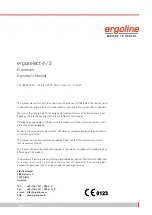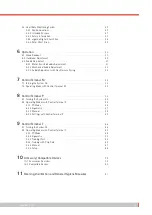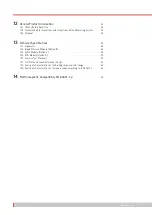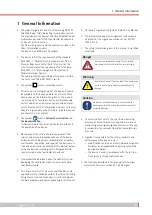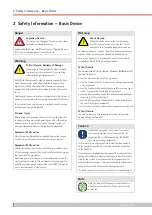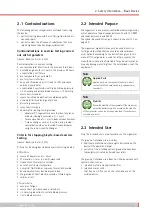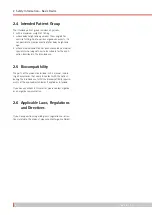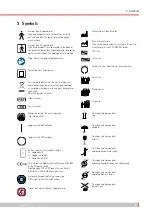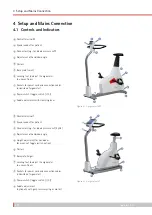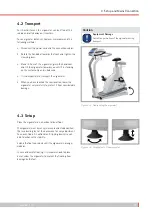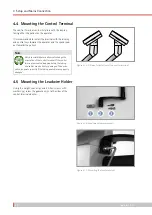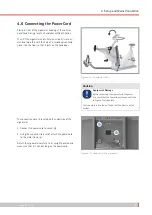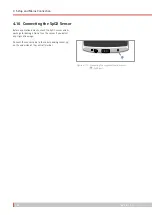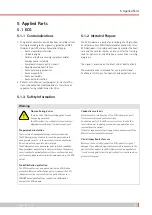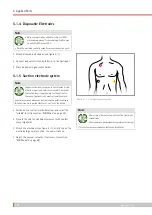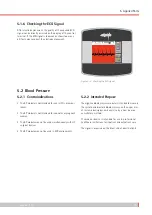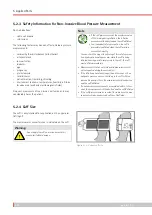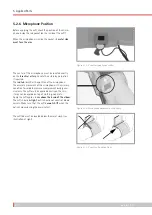
2 Safety Information – Basic Device
ergoselect 4 / 5
7
2.1 Contraindications
The following patient categories are excluded from using
the device:
• patients feeling discomfort or suffering from dizziness,
nausea or pain.
• patients under the influence of substances that may
impair vigilance (alcohol, drugs, medication).
Contraindications in exercise testing carried
out with ergometers
(source: Banerjee A et al., 2012)
Contraindications in exercise testing:
• acute myocardial infarction in the previous 4 to 6 days
• unstable angina with rest pain in the previous 48 hours
• uncontrolled heart failure
• acute myocarditis or pericarditis
• acute systemic infection
• deep vein thrombosis as it is likely to shift and cause
pulmonary embolism
• uncontrolled hypertension with systolic blood pressure
> 220 mmHg or diastolic blood pressure > 120 mmHg
• severe aortic stenosis
• severe hypertrophic obstructive cardiomyopathy
• untreated life-threatening arrhythmia
• dissecting aneurysm
• recent aortic surgery
• abnormalities during testing include:
− abnormal ST-segment response (horizontal, planar,
or down-sloping depression of > 1 mm).
− T-wave elevation of > 1 mm in leads without Q-waves.
− T-wave changes such as inversion and pseudo-
normalization when an inverted T-wave becomes
upright are non-specific changes.
Criteria for stopping bicycle-based exercise
testing
(source: Banerjee A et al., 2012).
Criteria for stopping bicycle based exercise testing include:
ECG criteria
• severe ST depression of > 3 mm
• ST elevation > 1 mm in non-Q-wave lead
• frequent ventricular extra systoles
• onset of ventricular tachycardia
• new atrial fibrillation or supraventricular tachycardia
• development of new bundle branch block
• progression of heart block to second or third degree
• cardiac arrest
Clinical criteria
• excessive fatigue
• severe chest pain, dyspnoea, or dizziness
• > 20 mmHg reduction in systolic blood pressure
• rise in blood pressure
2.2 Intended Purpose
The ergoselect is a computer-controlled medical ergometer,
which operates at pedal speeds between 30 and 130 RPM
and loads between 6 and 999 W.
The speed-independent range is shown in chapter
The ergoselect ergometer may only be used in exercise
testing and for rehabilitation of cardiac and cardiovas-
cular patients according to the instructions given in this
manual. If the ergometer is used for other purposes, the
manufacturer cannot be held liable for personal injuries or
property damage resulting from the unintended use of the
equipment.
Note
Applied Parts
Applied parts are components that are in direct
contact with the human body (e.g., sphygmoma
nometers).
Note
Stability
Ensure the stability of the ergometer. If the maximum
permitted patient weight is exceeded, the stability
of the ergometer can no longer be guaranteed. It may become
unstable as a result.
2.3 Intended User
Only the intended users are allowed to use the ergometer.
The group of intended users includes:
• healthcare professionals thoroughly instructed on the
basis of the operator manual
• patients of the intended patient group who have been
thoroughly instructed by trained specialists
The group of intended users does not include persons with
special needs, such as:
• impaired mental and physical abilities
• impaired motor skills
that have an influence on the intended use of the
medical device.
Summary of Contents for ergoselect 4
Page 1: ...ergoselect 4 5 Ergometer Operator s Manual 201000433000 Version 2021 06 01 Rev 04 English...
Page 2: ......
Page 95: ......



